Trauma, Oppression & The Body
Trauma is not only about what happened to us, it’s also about what happened before us, and what continues to happen around us.
Many of the wounds we carry are personal, yet they are also shaped by histories of oppression, inequality, and marginalisation. Whether it’s through experiences of violence, loss, discrimination, or intergenerational trauma, our stories are often entangled with systems and legacies much larger than ourselves.
In my work, I hold space for both, the individual and the collective, recognising how trauma can live in our bodies, our families, and our communities. Healing involves not only making sense of painful memories, but also reclaiming the dignity, agency, and identity that trauma and oppression can strip away.
I am trained in three evidence-based approaches to trauma therapy:
EMDR (Eye Movement Desensitisation and Reprocessing): A structured, research-backed therapy that helps the brain reprocess traumatic memories so they no longer feel as overwhelming or defining. EMDR uses the body and is less language focused than traditional talking therapy.
Narrative Exposure Therapy (NET): A method that helps people piece together fragmented memories into a coherent life story line, honouring both survival and resilience. I am also trained in child NET (Kid-NET). This involves creating a timeline and grounding in the here and now with tools.
Narrative Therapy for Trauma (Tree of Life / Theatre of Life methodology): A creative and culturally sensitive approach that I have published and teach on, supporting people to explore trauma through story, metaphor, and meaning-making, reconnecting with strength, values, and community in a way that makes them stronger.
For some, trauma feels acute and recent. For others, it may be inherited, woven through generations via silence, shame, or survival strategies that once protected but now constrict. Understanding trauma in this broader, systemic way allows us to move beyond “what’s wrong with me?” toward “what happened to me, and to those before me?”
Healing from trauma and oppression is not about erasing the past, but about re-storying it, finding ways to integrate what has happened, acknowledge the resilience that endures, and imagine new possibilities for the future.
Our Multi-Storied Bodies
I’m strongly influenced by the work of Poh Lin Lee and Helena Rose, especially their paper Our Multi-Storied Bodies. Their idea is simple and helpful: we’re not just one single story. Our bodies and lives carry many layers shaped by family, culture, history, migration and the ways power works in the world.
In therapy this looks like paying attention to those layers, the sensations and emotions in your body right now, the personal story you tell about your life, and the bigger family or cultural stories that sit behind those experiences. I work with these layers using creative and practical tools (for example, Tree of Life / Theatre of Life practices). I aim to work with you as a collaborator, exploring your stories together, noticing the impact of wider systems, and finding sources of strength that stretch across generations.
This approach helps us hold painful memories without becoming defined by them, and to notice the resilience and meaning that often sit beside the hurt.
Invitations to you and your body
I’d like to offer an invitation to ask your body some questions about exploring therapy to see what it says. Take one slow breath. Imagine your body as a community of parts, where different members of the body are: sensations, memories, people, roles, places. When I say “body” this can mean places in your physical body, people you carry with you, more-than-human or natural world elements, or parts of your social identity.
What does body say initially: before anything else: notice what arises when you imagine exploring talking therapy or support: maybe sensations, images, a person you carry. Where do you feel it in body? What does arm say for exmple? What do feet feel? Is there curiosity, resistance, relief, or something else?
Gently arrive: just look around you and your body as you read, who or what do you notice as present right now? Where in body is loudest, most vocal, or most curious?
Consent and pause: do these members consent to exploring or taking up these positions, or do any wish to settle, rest, or step back for a while? do parts of body feel hesitant about exploring therapy, and if so which parts of body?
Quieter members: are any body-members quieter, less noticeable, elsewhere in a different time or space, or hesitant to be here?
Noticing shifts: how might you tell if consent changes during a session, a part who agreed wants to step back, or a quiet part wishes to come forward?
The body as community: how does your body-community respond to these invitations? What changes when we offer consent to parts of ourselves, remembering that consent and relationship can be multi-storied?





